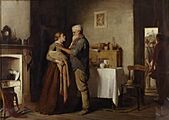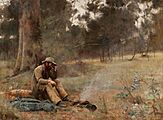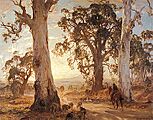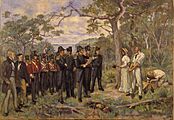Art Gallery of Western Australia facts for kids
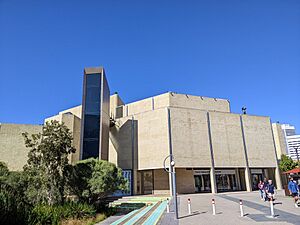 |
|
| Established | 1895 |
|---|---|
| Location | Perth Cultural Centre, Perth, Western Australia |
| Type | Art gallery |
| Collection size | 18,000 |
| Visitors | 148,301 (2021) |
| Owner | Government of Western Australia |
| Public transit access | Perth railway station, Transperth |
| Official name | Art Gallery & Museum Buildings |
| Type | State Registered |
| Designated | 28 August 2001 |
| Part of | Perth Cultural Centre |
| Reference no. | 1962 |
The Art Gallery of Western Australia (AGWA) is a public art gallery in Perth, Australia. It is part of the Perth Cultural Centre, a place with many cultural buildings. AGWA is located near the Western Australian Museum and the State Library of Western Australia. The gallery is supported by the Government of Western Australia. The main gallery building opened in 1979. It is connected to an older building called The Centenary Galleries.
Contents
History of the Art Gallery
The Art Gallery first shared a building called the Jubilee Building. This building was also home to the State Museum and Library. The Jubilee Building was meant to be a public library. Its first stone was laid in 1887 to honor Queen Victoria.
The foundation stone for the Art Gallery itself was laid in July 1901. This happened shortly after Australia became a federation. The Duke of Cornwall and York laid the stone. Many important people helped develop the Jubilee Building and the Art Gallery.
Buildings and Design
The Art Gallery's administration office is in a building that used to be police quarters. An architect named Hillson Beasley designed it. This building was constructed during a time when Western Australia had a lot of money. This was due to the gold rush in the 1890s. The administration office moved into this building in the 1970s. This was during another mining boom, this time for nickel.
The main gallery building was built in 1977. Its construction was also helped by the mining boom. Western Australia was starting to value cultural places more. The government was also preparing for Australia's 150th anniversary in 1979. The Alexander Library Building was also built around this time.
Charles Sierakowski designed the main gallery building. He worked with an engineer and an architectural company. The building was designed in the Bauhaus style. It has a Brutalist look on the outside. This style was popular in Europe. The way the building's slabs and columns were put together was new for Western Australia.
New Projects and Spaces
In 2017, AGWA announced plans to improve its rooftop area. This project was called "AGWA Elevate." It aimed to create a space for sculptures, events, restaurants, and films. This new rooftop area opened in November 2021. The state government gave $10 million for this project.
In the same year, a project called "Six Seasons" began. This project aimed to show more Indigenous Australian art. A new gallery dedicated to Indigenous art opened. It was part of a special exhibit called "Plain Speak."
Art Collections and Exhibitions
The Art Gallery's collection was partly inspired by the Aesthetic Movement. This was a style of art and design.
AGWA has ongoing exhibitions. These include traditional and modern Indigenous art from the Northern Territory and Western Australia. They also show Western Australian art from the 1820s to the 1960s. The gallery also has special displays about different themes from its collection.
Special Art Projects
Desert River Sea: Kimberley Art Then and Now is a big project that started around 2013. It explores Indigenous Australian art from the Kimberley region. A company called Rio Tinto helped fund this project with $1.8 million. In 2019, an exhibition called Desert River Sea: Portraits of the Kimberley was held. This was the result of a six-year project. It involved AGWA and Aboriginal artists from six art centers in the Kimberley. There is even a special website for this project.
Each year, AGWA shows art by talented high school students. This exhibition is called Year 12 Perspectives. In 2018, 55 artworks were shown.
Art Prizes and Awards
AGWA hosts several important art prizes. These awards celebrate talented artists.
The Lester Prize
The Lester Prize is one of Australia's most valuable portraiture prizes. It used to be called the Black Swan Prize for Portraiture. About 40 final artworks are shown at AGWA every October and November.
Tina Wilson started the Black Swan Prize in 2007. In 2014, the prize included an award for art showing Perth's heritage. The award moved to AGWA in 2016. In April 2019, the prize was renamed The Lester Prize. This was to honor its main supporter, Richard (Dick) Lester.
As of 2022, the main prize is worth $50,000. Other awards include the Minderoo Foundation Spirit Prize and the Tony Fini Foundation Artist Prize. The total prize money is $105,000. In 2022, 720 artists from all over Australia entered the competition.
Tom Malone Prize
The Tom Malone Prize (TMP) is also known as the Tom Malone Glass Art Prize. It was started in 2003 by Elizabeth Malone. Since 2018, Sheryl Grimwood has supported it. This prize is for modern glass art. The gallery buys the winning artwork for its collection.
In 2022, the prize was worth $15,000. It celebrated its 20th year. In 2023, the prize money increased to $15,000. The shortlisted artworks were shown at a new place in West Perth.
Some past winners include:
- 2005: Clare Belfrage
- 2011: Clare Belfrage
- 2019: Mark Eliott, Down at the water table
- 2020: Mel Douglas, Tonal Value, 2019
- 2022: Tim Edwards, Ellipse #8
Images for kids
Gallery
-
John Longstaff, Breaking the News, 1887
-
Frederick McCubbin, Down on His Luck, 1889
-
Hans Heysen, Droving into the Light, 1921




